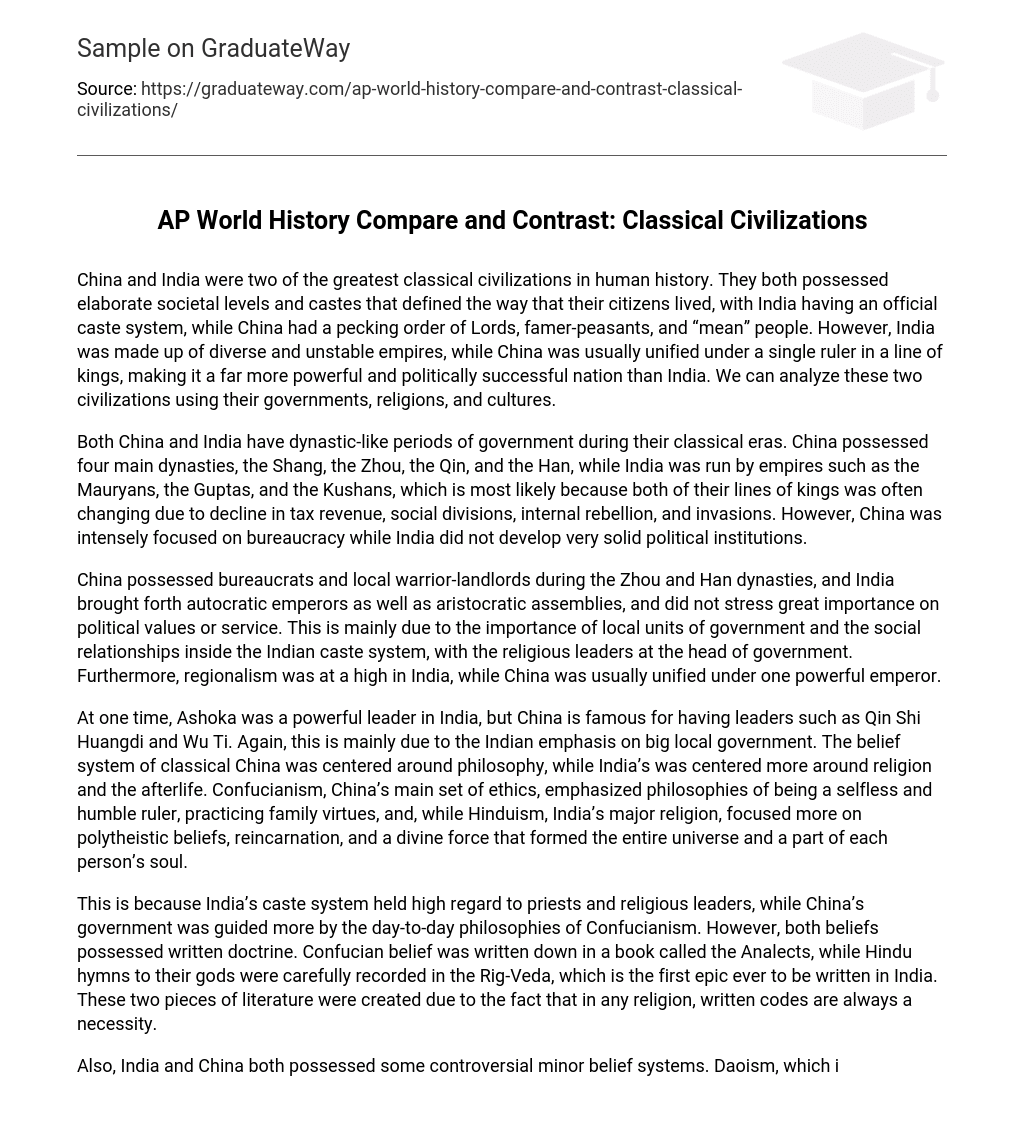Both China and India were ancient civilizations that possessed intricate social structures. In India, this was evident through a structured caste system, while China had a hierarchical system encompassing Lords, farmer-peasants, and “mean” individuals. Nevertheless, India stood out for its diverse and unstable empires, whereas China enjoyed political stability under the rule of a single monarch from a lineage of kings. To gain deeper understanding of these civilizations, it is crucial to analyze their governments, religions, and cultures.
During their classical eras, both China and India underwent periods of dynastic-like government. In China, the Shang, Zhou, Qin, and Han dynasties held power while in India empires like the Mauryans, Guptas, and Kushans reigned. These shifts in leadership were influenced by factors such as declining tax revenue, societal divisions, internal uprisings, and invasions. It is worth mentioning that China focused on bureaucratic systems while India had less robust political institutions.
During the Zhou and Han dynasties, China had bureaucrats and local warrior-landlords, while in India, autocratic emperors and aristocratic assemblies emerged, with less emphasis on political values or service. The difference can be attributed to the significance of local government units and social relationships within the Indian caste system, where religious leaders held governmental authority. Moreover, regionalism was pronounced in India, whereas China generally remained under the rule of a powerful emperor.
Ashoka, once a significant leader in India, is overshadowed by the renowned leaders Qin Shi Huangdi and Wu Ti of China. This difference can be attributed to India’s emphasis on extensive local governance. Ancient China’s belief system revolved around philosophy, while India’s centered more on religion and the afterlife. Confucianism, China’s predominant ethical code, emphasized selflessness and humility in rulers as well as practicing family virtues. On the contrary, Hinduism, India’s primary religion, stressed polytheistic beliefs, reincarnation concept, and a divine force responsible for creating the entire universe and inheriting part of each individual’s soul.
In India, the caste system gave great importance to priests and religious leaders, while in China, the government was more influenced by the daily philosophies of Confucianism. Despite these differences, both beliefs had written teachings. The Analects documented Confucian beliefs, while the Rig-Veda recorded Hindu hymns to their gods. The Rig-Veda is recognized as India’s first epic. These literary works were created because it was universally understood that having written guidelines in any religion held significant importance.
Both India and China possessed controversial minor belief systems. In around 500 B.C.E., Daoism emerged as a religious philosophy that emphasized living harmoniously with one’s surroundings and leading a humble and frugal life. Buddhism, which greatly impacted Daoism as the Han dynasty declined, focused on the teachings of the Buddha and sought to achieve enlightenment and attain nirvana in the afterlife.
Two religions emerged as a result of the people’s desire for a more devout life and internal conflicts within their respective religious streams. The social structure of India and China encompassed intricate levels and castes that influenced their populations’ ways of life. In India, there existed an established caste system, with priests and warriors occupying the highest rank, followed by traders and farmers, common laborers, and finally the lowest group known as the Untouchables.
China had a hierarchical structure with Landlords being the highest level, farmer-peasants at the middle level, and the “mean” or unskilled individuals at the bottom. These systems aimed to maintain order and hierarchy within the population. Notably, Chinese artistic expressions were predominantly seen on paper, while Indian art took the form of sculptures. Chinese calligraphy and painting reached their zenith, while Indians created ornate sculptures and temples to pay homage to the Buddha. Religious influences clearly distinguished Indian art from its Chinese counterparts.
Furthermore, Chinese science focused on astronomy, creating an accurate calendar of 365.5 days and studying the movements of Saturn and Jupiter. In contrast, Indian science excelled in medicine, making advancements in surgery, wound sterilization, and disease inoculation like smallpox. Chinese astronomy aimed to predict celestial phenomena and establish harmony between heaven and earth, while Indian medical research prioritized the well-being of the Indian population.
China and India are two captivating civilizations with intricate traditions in calligraphy and sculpting. They both have distinct philosophies and religions, with Confucianism revered in China and Hinduism holding great significance in India. These civilizations can be examined from different angles, including religion, government, and cultural diversity. Despite their geographic separation, China and India share the common status of being highly successful and influential empires throughout history.





